
|
|
|
Search our site
Check these out    Do you have an entertaining or useful blog or personal website? If you'd like to see it listed here, send the URL to leon@pawneerock.org. AnnouncementsGive us your Pawnee Rock news, and we'll spread the word. |
Too Long in the WindWarning: The following contains opinions and ideas. Some memories may be accurate. -- Leon Unruh. Send comments to Leon February 2007Leon Miller, entrepreneur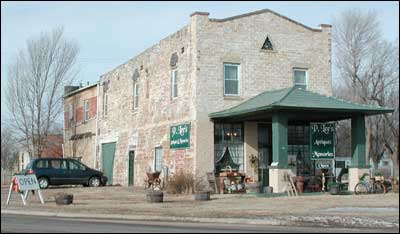
Pawnee Rock's opera house, then Knights of Pythias Hall, gas station, the Rock Cafe, and most recently antique store. [February 28] I received couple of notes in the past week from Leon Miller, the Pawnee Rock-bred architect who lives in Dallas. The first e-mail explains a little about the old opera house, which his father, Mobil distributor Maurice "Cobb" Miller, owned until his death in 1967, and the second one is about Leon's business adventure: My first recollections of the KP Hall go back to the late 1930s and early '40s. I remember my father having customer relations meetings for his customers in this large room on the 2nd floor. This probably was where the original opera house performances took place. I remember some paraphernalia in a closet that included a skeleton and some robes that were worn by either the actors or were part of the KP organization. As one of the pictures in your gallery pointed out, there was a Texaco station in this building at one time. I don't remember who owned it but do recall gas pumps along the highway. In my high school years there was a man named Frank Brazda who had a cafe there and the local teenagers liked to hang out there as he would sell them beer (the 3.2 kind). I'm not sure who came after him. My father bought the place in 1956 with the purpose of having a retirement income from rentals. He rented the cafe to a man named Svoboda who served meals for a number of years. The 2nd floor was never occupied for any public use or business purposes during his years of ownership. I myself ran a business in the former Stella's Cafe location in the summer of 1956. I enjoyed your memories of Virginia Fry in today's column. I grew up with her sons, Ralph and Hubert. Ralph and I graduated together from PR in 1951. Hubert was a year or two younger. Hubert was a U.S. Air Force pilot in the Korean War era and was tragically killed in a plane crash when the jet he was flying "flamed out." The last time I visited with Ralph, 3 or 4 years ago, he was a financial planner in the Seattle, WA, area. You mentioned about the various businesses and buildings along "Main Street." I came home from Fort Hays State in May 1956, looking for something to do until I enrolled in KU for the fall semester. I had been accepted in the School of Architecture and was anxiously looking forward to the challenge of attending the University.  In the meantime, I was given the opportunity to experience the first fruits of running a business as a man who had the cafe/gas station on the northeast corner of Centre Street and U.S. 56 died of a heart attack. He had this cafe/gas station where my Dad sold him Mobilgas for a number of years and his death was totally unexpected. Dad asked me if I wanted to try this out for the summer and I said "Yes." The man had run is business in a very blase manner and had put very little effort into its operation. So, when given the opportunity, I hit it with all fours on the ground with the intent of making a go it. I started with the gas station operation; checking air in the tires while pumping gas, washing the windshields of the cars and checking the oil of every customer who came in. These things had never been done before. And service became the norm, rather than the exception. Inside the cafe, I made hamburgers twice the size that the previous owner had done, creating a reputation and building a customer base whereby I often would take orders for hamburgers but discover I was out of hamburger meat or buns and have to run across the street to Hixon's grocery store and buy a pound or two of hamburger, race back to the cafe, put the meat on the grill and convince the customer that if he waited long enough he would taste the most marvelous hamburger he had ever eaten! IT WORKED! The business was going so good that summer that I began to question the impending closure and trip to Lawrence to enroll at KU. But fate entered into the operation as a local outfit in Great Bend, by the name of Hudson Oil Company, owned by a vary cantankerous lady named Hudson, started a "GAS WAR" (which she was known to do) and sold regular gas for as little as $0.12 per gallon. My Dad's cost was $0.15 per gallon so in order for me to break even I had to sell the gas for $0.18 per gallon. Subsequently, I was forced to throw in the towel, sell the merchandise I had on hand at FIRE SALE prices and tuck my tail for Lawrence. I will forever cherish that summer and what it did for me to stand up to competition and go toe to toe with it. It also helped me with my first year at KU which was extremely challenging. My customers in the Pawnee Rock community were very supportive but the economics of the outside competition closed me down. -- Leon Miller Pioneer and friend of Buffalo Bill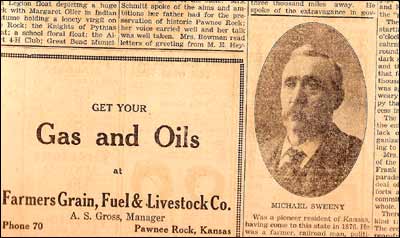
Michael Sweeney, published on the front page in 1937 in The Pawnee Rock Herald. [February 27] I was looking through old Pawnee Rock Heralds last night and came across a couple of stories about a pioneer Pawnee Rocker. The first story, published Thursday, May 28, 1922, reads: Pioneer Kansan Dead."Michael Sweeney, frontiersman, railroad builder and pioneer died at his home near here at one o'clock Sunday afternoon. "Mr. Sweeney came to Kansas soon after the close the war and pushed into the western plains with the Union Pacific railroad. He was with the road as far west as Goodland. He was an acquaintance and friend of many of the border characters of those early days. He was at Dodge City before the railroad and was with Sheridan and Custer at Camp Supply. Mr. Sweeney was a witness of or a participant in many of the stirring events of the later '60's or the early '70's and he was one of the few remaining land marks that bound the romance and adventure of the early days to the achievements of the present. "It was in the early years of the '70's that Mr. Sweeney settled on the farm near Pawnee Rock which has been his home since. Success came with the years and his neighbors have honored him with the confidence that goes with official position. A year ago he was hurt in a fall and was confined to the house for months. He has been able to get out into the yard on nice days this spring but he has not been robust since the accident. "Mrs. Sweeney died last July and there are three sons, five daughters left to mourn his loss. They are Mrs. John Mooney, of Hanston, Mrs. Jim Fleming, of Larned, a daughter who lives in Washington and Alice and Lillian and the three boys, James, Ed and John who live at home. "The funeral services were held at the home Wednesday and the remains laid to rest in the Pawnee Rock cemetery." And this was published on Thursday, May 28, 1937, in The Pawnee Rock Herald and The Albert News (the papers were by then combined). The issue commemorated the 25th anniversary of the dedication of Pawnee Rock State Park. (Even in those days, newspapers were careless with prominent names, shorting Mr. Sweeney one e.) [2009 note: Sweeny is the correct spelling.] Michael Sweeny"Was a pioneer resident of Kansas, having come to this state in 1876. He was a farmer, congressman and builder -- a man who helped make Kansas history. He was on the site when Hays was laid out and was the first county clerk of Ellis county, in 1869. In Hays he became intimately acquainted with Wm. Cody. Cody was a water hauler for the Union Pacific railroad but later he was hired to furnish meat for the railroad workers and bcame an expert in hunting buffaloes -- hence the name 'Buffalo Bill.' In 1873 Mr. Sweeney came to Pawnee Rock and was made the first station agent for the Santa Fe railroad here. He died April 2, 1922." • • •Lillian Sweeney lived for decades longer on the family farm a mile south of Pawnee Rock. My dad spent many afternoons out there performing some carpentry and maintenance, and Lillian and he became good friends. As the years passed, she gave Dad boxes of old photos and newspapers. That's what you're reading from today. Neither story mentions that Michael Sweeney was elected to the Kansas House of Representatives in 1901 or that his farmer-stockman son, James (born 1874), was elected to five terms (1935 to 1943) in the House. They were Irish and they were Democrats. Lillian's gone now too, and the farm has been plowed under. But her thoughtfulness in keeping the newspapers and in passing them on is a gift to us all. Close to the call of the wild[February 26] Virginia Fry grew up around Pawnee Rock and went to college at Fort Hays, then came back and taught fourth graders the value of adventure. She took us page-by-page through our world geography books and made it real. She gave us foods (squid legs, for example) that our parents would never have thought to put on the table at home. She told us about bush pilots in Alaska, camels in Arabia, and Marco Polo in China. Now, I've never been off the continent, except for a week in Hawaii, and my list of grand adventures is mostly written under the "I plan to" heading. But I live very close to people who do live big. Mountain climbers. Coast Guard rescue jumpers. Iditarod mushers. I'm not ashamed to admit that part of the fun of having moved to Alaska is that I can claim to be obliquely associated with those folks. My wife has been taking Buddy, our husky (half Lab, half greyhound, half lightning bolt) around Knik Arm to obedience school in a town called Wasilla. The instructor, a veterinarian who grew up in Germany, is married to a man who also moved from Germany to Wasilla to marry her and mush dogs. 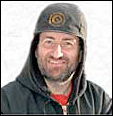
The musher, Frank Sihler, is one of several dozen who'll start the Iditarod Trail Sled Dog Race next Saturday. They'll race day and night over the following 10 or 12 days to Nome, a distance of 1,100 miles. Imagine guiding a dog team from Pawnee Rock to Spokane, Wash., or to Pittsburgh, Pa., crossing several mountain ranges but not a single road. My wife came up with the idea of fixing up a website for Frank. So we did. There's a big difference between setting up a website and hitching 16 dogs to a sled, and I'm glad to take my mushing adventures second-hand. Long-distance mushing may not be as tough as it was in the days when "The Call of the Wild" was written, but it still takes a lot of guts and stamina. Think about it: You cross some of the world's prettiest country with a dozen or more of your best friends; moose, icy gorges, and bitterly cold nights are your hazards; schoolkids hang on the Internet to catch your times between checkpoints; and office workers place bets on when you and your dogs will run under the big wooden arch in Nome, where miners still pan gold out of the subarctic beach. That's an adventure any fourth-grader could get into. And four decades later, I am glad to stand on the fringe. Thanks for helping me get here, Mrs. Fry. Donna from Dundee[February 25] I got a nice e-mail from Donna Smith Boese this weekend. She's now the associate registrar at Southwestern College in Winfield, but you may remember her as a student in Pawnee Rock Junior High when the high school was closed. Even though she lived in Dundee, very close to Great Bend, she went on to Macksville with many of us and was one of my sister's best friends.  Dundee had quite a few kids in the Pawnee Rock schools. The ones who come to mind from the 1960s and '70s are: The Claphans; Kenneth Henderson; the brother and sister Lamb; Rhonda Mason; TaWanna Mason; Gale Morgan; Verlin Morgan; Galen Rowan; Bill Smith; Chuck Smith; Donna Smith; Benita Unruh; Dale Unruh; Lois Unruh; and Steve Unruh, although he may have graduated before the family moved from Pawnee Rock to the old family farm. Even though Dundee was almost the definition of "wide spot along the highway," it had a lot of ties to Pawnee Rock. The Mennonite settlers staked their claims there in 1875. The concrete grain elevator still carries the "Pawnee Rock" label. And for those of us who frequently drove between Great Bend and Pawnee Rock, Dundee was the dividing point between the county-seat sprawl and the wide-open farmlands of the greater Pawnee Rock area. As Dundee's population dwindled, the speed limit through town was raised, which seemed to be flirting with trouble as drivers whipped around the curves accommodating the elevator complex. (I still slow down.) And even though the Arkansas River's dry, people still turn south at the bent cottonwood to go to the diversion dam -- the younger ones to shoot firecracks and firearms and drive their four-wheelers, the older ones to remember when fish splashed across the spillway. It was good to hear from Donna. I think of her and I smile, and I think of her hometown and I am a little surprised to find it meant so much to me. River of sand: Speaking of the Arkansas, the Hutch News is starting a series of stories looking at the river and where its water has gone. Check out the first installment. A photo I like: No. 25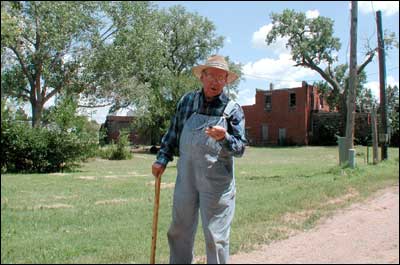
[February 24] No matter how many times my dad walked this alley between home and the post office or his shop or the elevator -- and he did it for about 50 years, day after day -- he always seemed to find something new and interesting. "Look at this," he'd say, holding out an odd rock. "Ever seen one like this?" Once in a while I amuse myself by looking at my current home as a tourist would: amazed by the mountains, stunned by a waterfall, impressed by the wind, suddenly aware that that's how people live here. It's fun, and it's a game anybody can play anywhere. Once in a while, I find a good rock, too. The elevators of our lives[February 23] Being a true Kansan and son the plains, I have always been drawn to anything that pokes high over the flat land. Trees, power lines, and especially elevators. 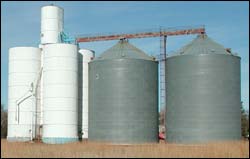
Elevators are our traveling landmarks; we judge how far we have to go by the size of the elevator on down the highway. But it's more than that. Elevators are tangible proof that central Kansas farmers do feed the world. Your wheat, corn, beans, milo -- it all goes into the big steel and concrete bins and then into a hopper car and then down the tracks to a flour mill or a cargo ship destined for another continent. Elevators are a kind of calendar in Pawnee Rock. We can look at old photos and judge our town's growth by the progression of wooden, concrete, and steel bins. Grain, and the elevators, have been with us since the 1870s; it's why our town is here. And now it's time to turn the calendar's page. The last elevator on the south side of the highway is coming down, to be replaced by a bigger model put up by Farmers Grain. It's a good thing, of course, although I still think it might have made a good restaurant. (And I thank Gary Trotnic for sending the photos found on today's homepage.) I hope that when the new elevator has risen to the sky, we'll still be able to walk there and see old foundation slabs from the Gano site and now this one. We like progress, but we also like to be reminded of what came before. To help us remember, I've created a special elevator photo gallery that features elevators from the south side of the highway. Some of the photos have appeared already on PawneeRock.org, but others are brand new to the site. Having them in one place should make it easier to appreciate that part of our history. Eventually I'll expand the gallery to include the elevators north of the highway. I had to start somewhere, however, and now seems like a good time to remember our old painted-steel friend and its predecessors. I suspect that I'm not the only one who is attracted to classic elevators. If you would like to contribute to this gallery or to the main gallery, please send photos to leon@pawneerock.org. Is everything sacred for sale?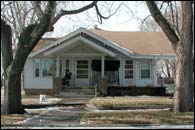
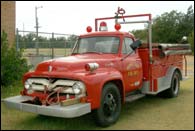
Click on the photos to go to the listings. [February 22] Sometimes the world spins so fast I can't keep up with it. Not only is the school sale apparently being wrapped up, but my favorite firetruck and the only Mennonite parsonage I've ever known are also begging to change hands. In a conversation the other day with Merita and Milton Rice, Merita mentioned that the City Council had arranged with Dewey Ball to sell the city's 1954 firetruck on eBay. She thought that when the city got the truck, Tom Flick had driven it all the way to Pawnee Rock. I guess that's appropriate: Tom and his family lived across the alley from the fire station. This is the truck that brought Santa downtown on a Saturday each December. The truck that saved houses and pastures. The truck that volunteer firefighters drove headlong to reach, parking across the street from the station and leaving their pickups almost before their engines were off. Now the truck, replaced by a newer model, has been sitting outside the school shop since at least last August, when I photographed it. It's a good truck, and I hope it makes some water-toting rancher or parade fanatic happy. And yesterday I was looking around for some Pawnee Rock real estate when I saw that Reep Real Estate in Larned had the parsonage listed. This fine old house, sitting like a rock at the intersection of Houck Street and Pawnee Avenue, has seen generations of Mennonites pass through it. With the church parked three miles north of town, the parsonage was the embodiment of our congregation in town. I suppose everything has to go on the block sometime; my childhood home was sold a year and a half ago, and your old house probably has left the family too. It's just hard to turn around one day and see another Pawnee Rock "institution" wear a price tag. In my perfect world, I'd buy the parsonage and the firetruck and give all Pawnee Rockers a ride on Saturdays past the old Methodist Church and the American Legion. Everyone gets to turn on the siren. Vote for good ideas[February 21] Pawnee Rock's politics and government once were close to a blood sport. As a high schooler in the 1970s, I'd walk next door to attend City Council meetings. Members droned on about federal block grants and such, but when they got to anything that touched the residents' lives, the place erupted. 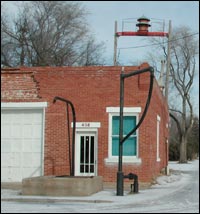
The council members sat around a folding table set up lengthwise in City Hall's narrow room. One or two members and the clerk sat next to the stove, and the mayor sat in the back, next to the shelves with the law books and the door to the jail cell, and faced the room. The unwashed masses, framed by the low bookshelves of the rotating library, sat in rows of folding chairs near the front door and windows. One meeting was dedicated to the issue of dog catcher. It seemed odd that newspapers and comedians made fun of the job, considering how heavily invested Pawnee Rock's citizenry was in the issue. People with dogs didn't want a dogcatcher, or they wanted one who wouldn't catch dogs. (Just drive around them, the owners said, and if they bite anybody, it's not our fault.) Sometimes folks worked themselves into a dither over taxes, but when the council retreated into discussions of mill rates, even I could see half the eyes glaze over. An agenda item about vandals and drunken kids, however, found the room packed with the angry parents of little angels. Being a council member was a tough job. Elections in those days were unhappy affairs. No one promoted himself or herself; doing so invited unholy misery because obviously those people thought they were better than anybody else. People with big ideas were viewed suspiciously because, well, just because. Mayor Dorothy Bowman, for example, served under that cloud. I hope it's different now. I'd love to believe that Pawnee Rockers vote for candidates instead of against them. I know the city has had several good people on the council lately. Now it's election time again. The dust has settled on the stack of candidate filings, and there are only three weeks left until early voting begins for filling the mayor's job and the open City Council positions. Mike Kirkman is the lone candidate for mayor, unless somebody runs a write-in candidacy. Mike now is on the council, having been appointed last May to fill out Sherri Johnson's unexpired term. Jack Link, who has been the mayor for most of this century, decided not to run again. Four men have raised their hands to join the council: Gary Adams, Joseph Billus, Timothy Parret, and Gary Trotnic. Voters will cast their ballots April 3 in the Pawnee Rock Depot. The election is under the control of the Barton County clerk. I don't live in town, of course, so my advice comes straight out of the peanut gallery. Nevertheless, I think Pawnee Rock will be well served if its residents vote for candidates with a passion for our hometown and thoughtful plans for its future. Help the candidates focus. Ask them what their ideas are. Questions for the school buyer[February 20] Congratulations on making the winning bid for the Pawnee Rock school/city building! We'd all like to find out more about you: Who you are, your connection to Kansas, what kind of company you have, what kind of jobs you'll offer, and whether the gym will be open to the public -- all kinds of questions. Please send an e-mail telling Pawnee Rock residents and expatriates about our town's newest landowner. (E-mail to Leon.) I'll post it here. This is your big chance to brag about yourself and make new friends. The yellow piano[February 20] There's something about a piano keyboard that makes me want to tickle it every time I pass one. Maybe it's knowing that playing a piano is the easiest way to make a pretty sound -- press a key and there's a tone. I like to sit down on the bench, wherever the piano is, and tap out songs I once learned. Most of those are from grade school, high school, and college, but that's enough to test my skills.  In my twerp years, I took piano lessons for a couple of years from Berdine Stansbury, so I have the basics. I'm sad to say that I never practiced hard enough to make my left hand do what I wanted it to. My sense of rhythm was also suspect. So I play the right-hand melodies, from the beginner's "Paladin" (C-D-E, E-D-C, C-B-A, C-B-A, A-B-C, E-D-C) to hymns to the romantic "Theme from Love Story" to KU's alma mater, "Crimson and the Blue." My other instrument -- the one I was better at -- was the trumpet, which played only one note at a time. I'm happy following the melody, as a trumpet does, but I do wish I could add harmonic counterpoint and timbre. I'm sure there's a life lesson in that desire. Like a lot of families in Pawnee Rock, our family had a well-worn piano. It was a stand-up monster, repainted a soft yellow, and someone with a lot of muscles lowered it down the steps into our basement. If I remember right, the piano was a castoff from the Christian Church across the street; it must have been played long and hard there because the keys looked like chipped teeth. We had it tuned once or twice when Cheryl and I were taking lessons, and after that the tones were only approximate. The bigger lesson from our piano was that we could explore music as we wished: the difference between notes, the way chords were put together, the flats and sharps that evoked certain emotions, and what happens when you bang both hands down with your fingers spread way out. The old yellow piano eventually became the big object we ignored, perhaps out of our shame for not practicing more, and at the end it was only a shelf to put junk on. But when I visited home in the piano's last years, I was happy enough to just walk by and lay my fingers on the keys to a thousand melodies. School sale seems to be at hand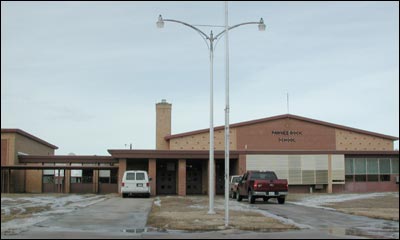
[February 19] It looks as if the city of Pawnee Rock is close to selling the school building. The City Council has accepted a bid for the school/city building, Mayor Jack Link told me Sunday evening. The council made the decision Saturday, and a Pawnee Rock resident e-mailed me a heads-up. The school was listed on eBay last June for $350,000, using Mid West eServices of Salina. In September, the price was lowered to $325,000. All would-be buyers had to tell the city what they planned to do with the property. The city received four bids, Jack said. If the deal goes through, the city will have to be out of the school by the end of March. Jack didn't want to go into the details of the pending contract, which has been sent back to the bidder. He'll have more to say when the contract is finalized, perhaps as soon as late this week. "It'll be a good deal for the town," he said. He was pleased with the company that submitted the winning offer. "They did stress in the business letter that they'll hire local people," he said. Jack said that although the building, which is in very good shape, would go to the buyer, the decades' worth of athletic and academic trophies would remain in the city's possession and would probably be kept in the city's new offices. "We're going to keep all the trophies. ... We fought too hard to get them," he said. The building opened its doors for classes in 1956, replacing a school that stood in the block immediately east of the school. Fort Larned USD 495 closed the high school in 1972 to much acrimony, followed eventually by the middle school and the grade school. The district gave the building to the city after that. (The mayor didn't say it, but word is that the city will move into the now-closed Methodist Church.) Like everyone else, I'll be sad to see the school go into private hands that aren't mine. Still, it's the biggest salable asset the city owns, and having a new property-tax-paying business and $325,000 or so in the bank may be better for Pawnee Rock than having $325,000 in real estate. The possible school sale isn't the only change on Pawnee Rock's horizon. Construction on the new sewer plant is expected to begin within a few weeks, Jack said. The plant will be on 9.5 acres between the Mennonite Church road and the current plant east of town along the highway. It'll be just north of the Farmers Grain anhydrous ammonia tanks. The new plant will use a lagoon system containing four pits; the current plant uses a mixer and a couple of ponds and is under state order to be replaced immediately. The new plant is expected to be odor-free, he said. In addition, Farmers Grain is building a $1.5 million elevator at the old Gano elevator site south of the highway. Things are looking good for Pawnee Rock. Construction money never hurts, and getting the new sewer plant will lift a big weight off the city's shoulders. 
Pawnee Rock's sewer plant, east of town, will soon be replaced. The Gano elevator site is at the far left, along U.S. 56. 
The Farmers Grain anhydrous ammonia tanks sit between the sewer plant and town. The new sewer plant will be built north of this property. 
The site of the new sewer plant, viewed from atop the Pawnee Rock State Park pavilion. The Mennonite Church road, invisible in this photo, runs where the two crops meet in the foreground. Once more around the track
[February 18] The old racetrack is gone, its quarter- or half-mile oval absorbed by the earth from which it was carved. The site was near the Barton County expo building and north of the airport's northeast-southwest runway and the current dragstrip. (You can see the outline in the aerial photo; click on it to get a zoomable image.) One Saturday night in the mid-1970s, Dale Unruh and I went to the track for the first time. The summer sun was sliding toward the horizon, and it didn't take long before the lights came on. The unmuffled engines roared like dogs eager to run. 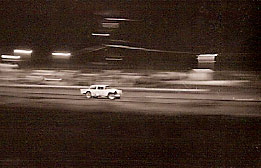
I didn't know any of the racers, although Dale might have because he had switched to school in Great Bend. As the cars spun around that little dirt track, I took photos and we turned to each other with grins to exclaim over some fender-bender or close finish. This all comes to mind because NASCAR opened its season this weekend. I've never been a motorhead, but our sons have been looking forward to the Daytona races since November, and this weekend is as merry as Christmas. For fun, the boys memorize stats about tracks and racers and cars, the way you and I might have followed George Brett's daily batting average. Nik woke me up Saturday by announcing that the very first NASCAR stock car winner had been from Kansas. It gets even better -- the winning car was from Great Bend. The year was 1949. The driver was Jim Roper, a Halstead fellow who read of the forthcoming race and got together with buddy Millard Clothier from Great Bend to borrow a couple of Lincolns from Clothier's dad, who ran a dealership. They drove the cars to the track in Charlotte, North Carolina. Roper came in second, but the winner was disqualified and Roper won for having the first legal car to cross the finish line. He got $2,000 and then drove home with a replacement engine because NASCAR had taken apart the winning engine. (Although some of this info is in Wikipedia.org and nascar.com, the best story was written by Jennifer Reents for the Newton Kansan when Roper died in 2000. Our sons spent Friday night watching the televised NASCAR Craftsman Series pickup race. On Saturday, they watched the Busch Series auto race, then replayed the action with Hot Wheels on a track laid out on Nik's wooden floor. Today, we'll watch the Nextel Cup Series' Daytona 500. The boys have seen NASCAR only on television, and they've never seen a dirt-track race. When we eventually do make it to a track, I'm sure they'll sprint up into the bleachers and spend the next two hours educating their old man. For now, we'll be cheering for Jimmie Johnson and Tony Stewart. Daytona International Speedway, right next to the Daytona airport. Two and a half miles around. Two. Hundred. Laps. Count 'em. I can't wait until the snow melts and the boys can play outdoors again. A photo I like: No. 24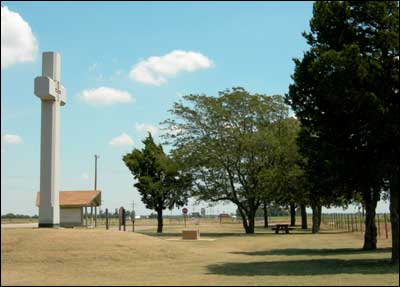
[February 17] I know the Father Juan Padilla cross is a little out of Pawnee Rock's neighborhood, but Padilla's history is tied in with ours. The Spaniards, led by Francisco Vasquez de Coronado, came up from Texas looking for Quivira in 1541. To reach this point, Padilla and the troop of soldiers marched north from Texas. When they realized there was no City of Gold, they went southwest past Pawnee Rock into New Mexico. (Pawnee Rock celebrated Coronado's visit in 1941.) Padilla came back as a missionary in 1542 and was killed near here; he is portrayed as the first Christian martyr in what is now the United States. That was 50 years after Columbus came to the Caribbean and 80 years before the Pilgrams set foot on the continent. I've stopped at this pullout on U.S. 56 west of Lyons a dozen times, but this past summer was the first time I've taken the time to read both markers and walk behind the cedars and just see what's there. Even at midday, it's a magnificent cross. You can sit on the mound or in the shade and imagine what it was like when the prairie didn't have a road or many trees and there was just one priest. Pawnee Rock, a sight to see[February 16] One Saturday morning in the late 1960s Chas Russell opened the door to Dad's carpentry shop and walked in with a stranger. And what a stranger he was, unlike anybody from Pawnee Rock. He had jet-black hair and his eyes were unusual. Chas introduced him to Dad (I was just a grade-schooler stacking boards by the bandsaw). This was a student from Formosa ("or Taiwan," Chas said) and he's here on our farm for a while. They talked for a while -- "How's your trip? I bet it's sure different here." -- and then Chas Russell and his companion went on to other sights. You know, we grew up in Pawnee Rock a little wary of the outside world but yearning to see it: Paris, the Ozarks, Mexico, California, Cape Canaveral, Egypt, any ocean. We were in the middle of the continent yet far from anywhere. We were under the flyways; we were a wide spot on a second-tier highway. All the roads led away from town. But here was a Taiwanese kid who, through some happenstance, had thrown his dart at the map and hit Pawnee Rock. He had grown up on a crowded island 125 miles from one of the world's terrible and ancient powers. How alien and daunting our windblown landscape must have seemed: a breadbasket state that stretched beyond the horizon, a land where farmers were still plowing under virgin grassland. I wonder what memories he took home. Were we beyond his wildest imagination? Cobb Miller, Mobil oil jobber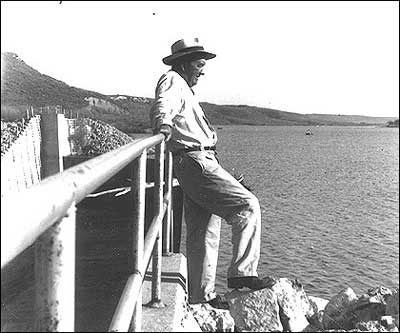
Cobb Miller on a vacation fishing trip, photographed by Dean Ross. [February 15] When I got an e-mail recently from M. Leon Miller, a retired architect in Dallas who grew up in Pawnee Rock (Class of 1951), I was curious about his family. Our photo gallery has an image of his dad, Maurice "Cobb" Miller, but I knew little about him. So I asked. Here's what Leon sent: "Maurice (also my first name) was one of the most diehard baseball fans anyone could have ever known. And one of his favorite players was Ty Cobb of the Detroit Tigers; hence, he picked up the nickname 'Cobb.' I remember him riding the train from Pawnee Rock to St. Louis, Missouri, in 1946 to attend the World Series. I think he went by himself. He lived and breathed baseball! Could you imagine doing that today? I heard people (nuts) were paying up to $25,000 to go to the Super Bowl this year. "As for Cobb's business; he started out in the 1920s as an agent for the White Eagle Oil Company, which was bought out by Socony Vacuum Oil Company, the precursor of Mobil Oil Corp. He became an independent jobber handling Mobil products in 1942. One of his supervisors got him a contract to provide fuel for the contractors building the air base at Great Bend, and if it hadn't been for this contract the fire he had later that year would have put him out of business. Up until the time of his death in 1967 at age 70, he was still an independent jobber for Mobil. "Our home was on south Centre Street, and was the second house from the county line road separating Barton and Pawnee Counties. The place today is in despicable condition. . . . "Dean Ross, Bing Gilbert, Norm Converse and my dad were the closest of friends and were on a trip to Florida when the picture you attached in the e-mail was taken. Unfortunately, they all died before my dad did." Sealed with a kiss[February 14] Any lost soul who thinks there's no hope in the world must have forgotten Valentine's Day. Valentine's Day, when we were ten years old and good looking, was the moment when we could be sure that the girl we had a crush on would reveal her true love to us. Our moms bought Valentine cards by the box at a drugstore or TG&Y or Duckwalls. There were a half-dozen playful designs per box of 20, and they all featured big red hearts. In those days, the cards were flat; you wrote your message right there on the front. On the night of February 13, we scripted our classmates' names and signed the cards and addressed the envelopes -- for boys and girls alike. But there was always someone special. Her card got a nuanced message, written visibly in ink and invisibly in blood. Her card was SWAK when Mom wasn't looking. On February 14, we carried the cards to our grade school classroom and slipped them into our decorated boxes. Everybody gave one to everyone else. When we dug through the "mail" and opened our would-be sweetheart's card, either first or last, we pretended not to give it too much attention. But there we were, trying to read between the lines (if she had written two) and glancing sideways to see whether she was watching us hold her card as lovingly as we'd hold her hand. Did she like our card? Things got so much easier in high school when cards gave way to the Valentine's weekend dance. These events followed a home basketball game on a Friday; if there was no game, the dance was on Saturday. As we got older, more and more of the kids went as couples; the rest of us said we were playing the field, as if that fooled anyone as wallflower danced with wallflower. Love -- even a crush -- was a longshot. But we danced and we dreamed, and we each remember the day when the prettiest lips in school smiled in the way that said, "Me too." Doyle Foster: Doyle Foster, a Pawnee Rock native who taught in Radium and Macksville and later became a principal in Larned, has died. He was born in 1916 to Mel and Ella Cooper Foster, and he graduated from PRHS in 1934. He'll be buried Thursday in Pawnee Rock Cemetery. (Obituary) Curtains for tradition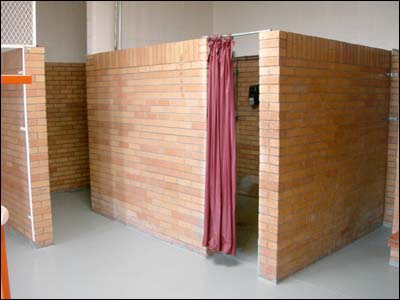
[February 13] I'll be the first to admit that I'm behind the times. During my time away, I never imagined that there would be a shower curtain in a school locker room. In my school days, this was the junior high locker room. "Bare bones" overstated its design. For most of us, this shower was our first exposure to, well, public exposure. (After all, who really showered at the swimming pool?) If there had been a curtain then, it would have been a quick victim of towel-snapping tough guys. Figuring out the protocol for decency and safety was a milestone for most kids. Fistfights and humiliation happened pretty often, spilling over from the basketball court or occurring just because some boys were bullies. All the Pawnee Rock parents who didn't want to discuss the birds and bees with their sons forfeited that opportunity to the class conducted in this room. Eighth-graders were only too glad to explain the world to wide-eyed seventh-graders. Despite what the eighth-graders wanted younger kids to believe, however, we all thought the real test of manliness was whether you were willing to walk home in the winter without drying your hair first. Photographic memory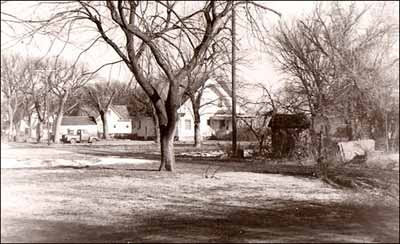
[February 12] Let's see what we can draw out of this photograph from Pawnee Rock in the early 1970s. This photo looks northeast from a spot in the alley directly north of the old city hall and fire station. That's another alley, a muddy one, on the right side of the photo. Several houses had driveways or garages off the alley. The property at the right of the photo contains what I think was an outhouse, but there was a shed near there the last time I looked and I may be mistaken; either way, there was a mysterious overgrown back yard with a big garden in the summers. The main house, which was painted mustard yellow and had large pines in the front yard, must have been one of the city's oldest houses until it was destroyed and eventually replaced by a manufactured house. The scrubby trees near the outhouse include osage oranges. The tree in the middle of the photo is on land once owned by Mr. and Mrs. Gene Bowman. Gene had a stroke one day, and it seems like not long afterward the property came to be occupied by Martha Koehn and Clara Schultz, who was one of my great aunts. As a kid, I mowed the yard around that tree, even though the grass was never watered and never grew tall. The big house in the photo was Alan and Dorothy Bowman's when this photo was taken. It was, and is, one of the most substantial houses in town, and it sits at the intersection of Centre Street and Bismark Avenue; Bismark runs left and right across the photo. The big round porch has for generations given residents a good view of the traffic headed to the Rock. Dorothy, who had strong opinions about how the town should be run, was mayor for a while and ran the PRIDE committee. North of that house is one owned by Howard and Carole Bowman. Howard has been mayor and at one time ran the gas station along the highway, and he worked at Farmers Grain too. North of their house is the Smith place, which sits on the edge of what was once a substantial farm. Between the Howard Bowman and Smith homes runs a ditch -- a channelized creek -- that carries runoff from the old salt plant pond down toward the sewer plant and then somehow into the Arkansas River, if the water lasts long enough. Many elms were amputated in the 1970s and '80s after the arrival of Dutch elm disease. You can see one such tree in front of the pickup. Behind where I was standing when I took this photo is a vacant lot that stretches to the fire station/city hall. The city stored its grader and tractor-mower under the elms on that lot, and sometimes there was a big pile of dirt or a stack of culverts. On occasion, the lot was used to burn branches the city collected. The dirt smelled of oil. This photo looks like one I would have taken in 1973 or 1974 as I was learning darkroom skills. I wandered around the block shooting birds, fences, buildings -- pretty much the kind of thing you see here in this photograph of a raw winter morning in Pawnee Rock. Eventually I learned to make well-composed photos, although I'm glad I saved pictures such as this. These are the ones that not only give my memory a reality check but that also free me to wander again through Pawnee Rock's alleys. Recently departed: Two men with Pawnee Rock connections have died recently. Their full obituaries are in the Great Bend Tribune: Jay Lee Rutt, who grew up in Pawnee Rock, died February 6 in San Antonio. He was born in 1941. The funeral is in the Pawnee Rock cemetery. (Obituary date February 11) Ed Philbern, who attended school in Pawnee Rock. He was born in 1934, and when he died January 30 he was living in Bunker Hill. His remains were cremated. (Obituary date February 4) In addition, a Larned man who is familiar to many of us, Bob McFadden, died February 2 in Larned. He was born in 1929 and owned Bob's Barber Shop in Larned. (He gave me my first barbershop haircut.) (Obituary date February 4) Feeding the preacher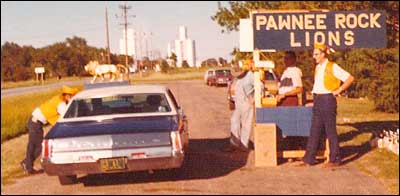 Gerhard Peters, right, at the Lions Club coffee stand at the Pawnee Rock historical marker, Labor Day 1973. [February 11] The day the preacher and his wife came to our house for a meal was the scariest day of our family's social calendar. Why the preacher and his wife came is still something of a mystery. I couldn't see why they hadn't already had their fill of us. We met at church, at school, at Lions Club, at the store, and at the post office. Pawnee Rock in the 1970s had 450 people, and there was no way to not see us. But every year, the Rev. and Mrs. Gerhard Peters tried to arrange a meal with each of the Bergthal Mennonite congregation's families. Perhaps it was a way to cut their food budget. Maybe household visiting was part of the preacher's job description learned in seminary. To be fair, maybe they cared about us. To my teenage mind, however, it looked like they were spying. Did we pray? Did we say the right kind of prayer? Did we have enough money to provide good food? Did we squabble? Would there be a come-to-Jesus speech? Would our family's foibles later become part of a sermon? Mom and Dad seemed especially uptight. I suppose that was reasonable, considering that they had to provide the meal, generate small talk, and make sure Cheryl and I didn't embarrass ourselves. I think we knew how to behave around the Rev. Peters. Mrs. Peters, Pauline, was a different story. She walked in the Rev.'s shadow, and I don't know that I ever had a conversation with her that lasted more than a minute. She had some experience with kids, though; she mothered two or three of them through the Pawnee Rock school. The Rev. filled any room when he walked in. He was tall and angular, with his hair swept back in a bit of a pompadour. He laughed, but it was laughter with a Germanic undertone that left me a little uneasy. That probably is because I knew I was neither a perfect Mennonite nor a perfect German. Still, were it possible, I think might enjoy sitting down with the Peterses now. Gerhard Peters directly and indirectly influenced my Pawnee Rock years so much that I would love one more chance to find out how. And why. 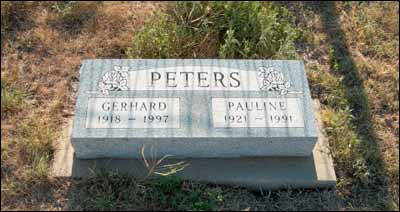 The Rev. Gerhard and Pauline Peters are buried at the back of the Bergthal Memorial Cemetery north of Pawnee Rock. A photo I like: No. 23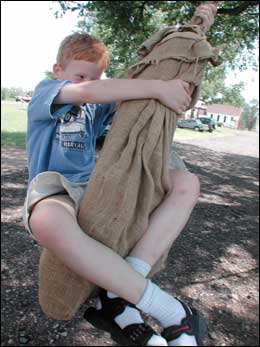
[February 10] It's an airplane! It's a pirate! It's a bird of prey! Don't tell me it's an 8-year-old riding a gunny sack filled with sand tied to a rope hanging from a cottonwood branch. This daring young man is son Sam at the Barton County museum south of downtown Great Bend. This July afternoon flight was his first time on such a device; he doesn't have a farm to grow up on, so he's deprived. Why do I like this photo? Because I can remember a young me grabbing the scratchy gunny sack, wrapping my legs above the seat, and flying into the clouds high above Kansas. Carry on, Kansas boy[February 9] I was digging through all the places in the house where music CDs could have wandered off to. Everyone else in the family thought I had lost the boys' copy of the Rascal Flatts album with the "Ellsworth" and "Life Is a Highway" songs. As I dug, I came up with an old treasure: a live-in-concert version of the "Dust in the Wind" album by Kansas, the rock band from Topeka. A long long time ago, around 1973, I saw Kansas at the Stone Lion club in southwestern Great Bend. A bunch of us Pawnee Rock boys drove over one evening when I was almost beer-drinking age. I didn't know much about the band -- no one did then -- but we liked the sound. Well, we especially liked the noise: loud, thumping beats and voices floating over it all. "Watch this!" one of the guys shouted. He put our pitcher in front of one of the vibrating speakers, and immediately the bubbles flooded to the top. Soon (within a couple of years) we were all singing "Point of Know Return," "Carry on Wayward Son," and that great real-Kansas song, "Dust in the Wind," which is perfect for so many occasions. "I close my eyes / Only for a moment, then the moment's gone," the song says. Rascal Flatts turned up in the bottom of a bag of gloves and hats. The journey to "Ellsworth" was long but worth it; I got to visit Kansas again. Pictures of Kansas: Get your photo fix here. Check out the work of Dave Leiker and Don Palmer. Snakes that could kill us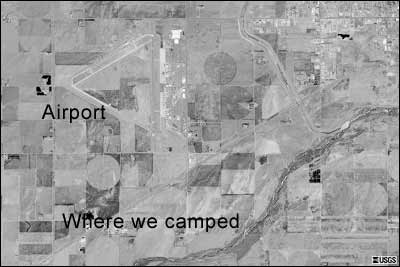 A Terraserver photo of the river in 2002. Click on it to go to a photo you can zoom in on. [February 8] Ron Keil worked at Brannan's Studio in Great Bend in the mid-1970s, helping out with the photography and working the counter. At the time, he must have been around 20 and a few years older than I. He sold me plenty of film, paper, and chemicals, and he was always ready to talk shop. It turned out that we both enjoyed camping, so we found ourselves one evening on a sandbar a couple of miles southwest of the U.S. 56 corner on the west side of Great Bend. The river was low, because it was summer, and the sand was hot. We built our fire, said a prayer at Ron's request, ate our meal, and got ready to hit the sleeping bags. But Ron had one other item on his list. He scratched an oval in the sand around our encampment -- the Lord told him it would keep snakes out. It didn't sound plausible to me, but I didn't argue. I had practically grown up along the river and hadn't even thought of snakes until he mentioned them. As you can imagine, I didn't sleep well that night; I watched the stars in the heavens and kept glancing down to see whether any of the devil's pets were slithering toward us. At dawn, I awoke not to snakebite but to the sight of a doe and fawn drinking from a backwater on the other side of the river, not 30 feet from us. The snake oval must have worked -- there weren't any snake tracks in the sand. Ron had slept soundly in faith. We set off down the sunny river as the heat rose, walking on the pebbly and muddy bottom in calf-deep water. Carp scooted away from us, darting to cover. A few hundred yards from our campsite, we came across a strange waterfall: an emerald fluid pouring into the river from a pipe buried in the north bank. It was viscous, like antifreeze. All these years, I've assumed it came from the industrial park at the airport, some castoff from a manufacturer without scruples. I don't know why Ron and I didn't tell the governor or a county official about it. Maybe our heads were baked, or I was tired from having spent the night worrying about snakes. But someone was obviously polluting the river -- our river. It was an open belief for the last years of the flowing river that most of the water passing by Pawnee Rock was put there to carry the effluent away from Larned's sewer plant. Although that was distasteful, at least the sunlight could kill the bacteria. The green fluid, however, was poison. It would have to be, or its owner wouldn't have hidden it. I'm sure that most towns did what they could -- or what the state said they had to -- to keep the river and aquifer clean. But once in a while, no matter how carefully you draw the line in the sand, a snake gets through. Newspapers smell like money[February 7] Jack Zygmond was a chain-smoking, coffee-absorbing, hawk-eyed newsman who became the editor of the Larned Tiller and Toiler. He never seemed to doubt for a moment any of his decisions, and he was sometimes terrifying to work for. 
Jack was a cash-flow guy, which my editing professor later explained. "The first duty of a newspaper," John Bremner nearly shouted, "is to make money!" Papers that don't make money go out of business and don't get a chance to right the world's wrongs. Jack had married into the family that owned the Tiller, and he had responsibilities. In 1975, however, he was subject to whims. One of them was hiring me right out of high school to work a couple of summers and winters as a reporter/photographer. That went OK. I saw Pawnee County at its finest and worst, I got lots of writing and shooting under my belt, and I was paid $75 a week, or almost $2 an hour; I didn't think to claim any overtime. The second of Jack's whims, as they involved me, involved the smell of money. I had the bright idea one summer day that we should mix perfume into the ink on the press and print a big ad that smelled good. What advertiser wouldn't like that? Jack cooked up a deal with one of the drugstores -- Wiggins or Ritzman's -- and came back to the office with a brace of perfume bottles. When the offset press was webbed up, pressman Pete Daniels stirred the perfume into the tray of ink from which a certain pair of pages would be printed. It was a really good idea, and I had fun seeing grownups put it to the test. When the press run began, Jack pulled a finished paper off the folder. He opened it, put his nose up close, and breathed deeply in search of a floral scent. Somewhere in this world -- maybe on the woman in front of you at church -- there's a perfume that is stronger than newspaper ink. On that day in Larned, however, we didn't have it. Our gentle perfume was lost. In all the excitement that day, I didn't write much. The only story I got was this one. The best part of our effort was that in a business that craves the sure advertising dollar, Jack Zygmond had gambled on whimsy. I got the impression from watching him that even though the paper didn't come out smelling like a rose, Jack liked rolling the dice. 
Photos of real life[February 6] As I glanced through the family photos sent to us by Mandy Sheldon, I thought of Life magazine -- the older version from the days before it was a weekend insert in newspapers. The magazine covered plenty of Big Events: presidential inaugurations and funerals, wars, football championships, and the construction of dams. But the genius of Life was that it also provided a high-quality look into hometowns and families: mom and the kids at the supper table, a teacher in the classroom, grandpa on the tractor, a doctor with a cigarette, dad at the lathe. They were honest-faced people in the middle of living. And that's what Mandy's photos show. Here at PawneeRock.org, we have lots of photos of parades, meetings, buildings, and the Rock. We all know, however, that those are just the background against we live. The important things are found in the foreground of family photos: the fleeting expression, the body language, the settings on the table. Shake or twist: As I wrote the preceding paragraphs, our house was shaken by an earthquake. A quick check of the local U.S. Geological Survey quake site showed that it measured 3.4 and was located about 20 miles north of our place. (Curious about your area? Here's the overall map.) This happens a lot, enough that some people who live elsewhere have wondered out loud why anybody would stay in a place where the earth could fall apart. I have to agree. It's crazier to live here than in Kansas, where the only hazards are grass fires, drought, and tornadoes. Earthquakes can't be forecast yet, but weather radar is so good now that you can find out a good 10 minutes ahead of time that some supercell is going to sweep your personal effects all the way to Nebraska (second item on this page). I guess the good thing about quakes is that, while they come like sharks, they don't come with related bad weather. We've had dozens of quakes, including some that really got our attention, over the years and yet our house is still in good shape. How many tornadoes would you put up with before heading to the mountains? Kit Carson and Pawnee Rock[February 5] "The tourist, who today, with all the luxuriance of modern railway appointments at his service, crosses the continent via the 'Atchison, Topeka and Santa Fe' route, will notice nearly midway between the Missouri and the 'Foot Hills' of the Rocky Mountains not far from the geographical center of the phenomenal State of Kansas, an isolated, rugged mass of brown sandstone rising abruptly from the painfully level prairie surrounding it." So begins an account of how Pawnee Rock got its name. It was written by Col. Henry Inman, and it was published in 1886 in the Stafford County Republican. Inman describes how Kit Carson and other individuals of a company of plainsmen who pioneered the Santa Fe Trail came to Pawnee Rock one day in 1823. I could tell you how the tale ends, but that would spoil your reading of Inman's lush writing. Read Inman's Kit Carson story here. Larry Mix of St. John, half of the Larry and Carolyn team that created the prize-winning Santa Fe Trail Research Site, sent that newspaper story for our entertainment and education. If you haven't been to their site, you might be amazed at the breadth of their information, collected and digested over many years. Here's more of the background Larry sent about Inman: After leaving the Army in 1872, Inman made his way to central Kansas and went into the newspaper business in Larned. In McPherson County, the town of Inman is named for him. Furthermore: "In his later years his talents were largely given over to the writing of books and stories of the Great Plains, the poetic spell of which held him fascinated. Too careless in his litreary methods to be regarded as an authority on the history of the Plains, he nevertheless to be regarded as one of the best interpreters of life on the Plains as it was before the building of the railways. He was the author of 'The Old Santa Fe Trail' (1895), 'The Story of a Great Highway' (1898), 'The Great Salt Lake Trail' (1899) and several other books. Colonel Inman died at Topeka, Kansas, November 13, 1899." I am embarrassed by how little I knew of the Santa Fe Trail when I lived along it; I guess it's a case of overlooking the jewel that was underfoot in favor of whatever was over the horizon. Over the past few years, I believe, I've started to get a grasp on the trail and its significance. Perhaps that perspective now comes from looking homeward. But while my attention was elsewhere, some people remained focused on the central theme of how our land was settled. I'm grateful to the Mixes and those like them who keep the trail alive. Do you remember Justin Allen? This letter arrived Sunday evening: Hello All, I am not sure if anyone reading this remembers the Allen Family. We lived in Pawnee Rock from about 1978 to 1988, the last 6 years of that at 101 Rock St. I haven't seen "home" since 1988 as I went into the Military and moved away. Anyway, I just wanted to tell you all that this is an awesome site and it brings back ALOT of memories as well as some sadness. The sadness comes from seeing pictures of places and things that I remember and the time that has passed since I was there. I am interested in finding out about homes and land for sale there as well as the local job market. I currently live and work in Colorado but would love to find myself back "home." Thanks for any and all information. Sincerely, Well, there you are, Pawnee Rockers. Can anyone send Justin some information about real estate and jobs? Game of the week[February 4] Eight-year-old Nik knows many nice people who could influence him in helpful ways. For example, there's one family in the Air Force that used to live close by. They have a son Nik's age, and young Hunter Hayes wants to go to Texas A&M just as his parents did. Showing some common sense and a little rebellion toward his dad, Nik also wants to go to college at A&M and study engineering. He told my wife a few weeks ago that he's tired of wearing Jayhawk shirts when he's never even been to the school. When the subject of KU-A&M football and basketball games comes up, Nik and I sit at opposite ends of the couch. That's the way it was yesterday. We recently got cable TV after having lived fine without it for seven years. It's expensive, but at least the boys can watch a better selection of educational shows (Mythbusters and NASCAR) and I can watch Jayhawk basketball. Thus, at 5 last evening, Nik and I watched Kansas and A&M play basketball. It was the first time Nik had seen a game from KU; I rose in stature when he found out that I had been to every home game (and to every KU game at K-State) during my four years there. We watched Mario Chalmers, who played high school ball seven miles from where we live now. We also saw Antanas Kavaliauskas from A&M, who because he once played at Barton County Juco might be the only player on either team to have stood on Pawnee Rock. If you're the kind of person I hope you are, you already know that Kansas gave away the game. Or, as Nik might say, A&M won. With a second left and KU down by three points, Chalmers took a long shot and missed. And who had the ball when the game ended? Kavaliauskas. I love Kansas basketball. I hate to watch Kansas basketball. Maybe Kansas needs more players like Kavaliauskas, who looks thuggish. Several Aggies have a hungry mean look, and KU's players have well-fed bodies and happy faces. It was obvious who wanted to win more. A different game may have been won, too. I'd better start buying maroon T-shirts and bumper stickers saying "My son and my money will go to A&M." At least it's A&M. What if it were K-State? A photo I like: No. 22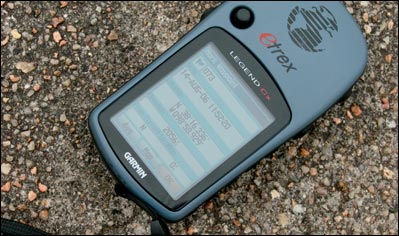
[February 3] I bought my first topographical map of the Pawnee Rock area when I was in junior high and a member of the Boy Scouts. It came in handy when I was plotting the routes I took on the way to earning my hiking merit badge. I have always been a Map Guy. As far back as fourth grade I was collecting state highway maps -- they were free back then -- from those tree-like wire stands found in chambers of commerce. So when I finally got my GPS unit last year, I had to take it to Kansas and find out exactly where I had been. As I drove toward Pawnee Rock from I-70, I found the 99th parallel, which is a few yards west of the north-south road just west of town. The photo here shows the center of the top of the pavilion in Pawnee Rock State Park in a decimal reading: 38 16.336 degrees north, 98 58.929 minutes west. (That's the same as 38 degrees, 9 minutes, 48.0960 seconds north, 98 degrees, 35 minutes, 21.4441 seconds west according to the FCC, and there's a plus/minus factor of a few feet.) The picture itself isn't any great shakes, but it represents a big jump in knowledge. That makes it my trophy. PawneeRock.org, or Grace Won Poker
[February 2] No peak crew: I got wrapped up last night with an online anagram generator. I tried my name, Leon Unruh (Oh Nun Rule), Great Bend Tribune (Gabbed Entire Turn), and Pawnee Rock (No Peak Crew). Go to Wordsmith.org to try your own name. Allergy: The Gallery of our Pawnee Rock photos has passed 300 images. We have photos from the 19th, 20th, and 21st centuries, and they're of people, animals, landmarks, artifacts, and buildings. I especially want to thank those of you who have sent photos to be displayed, but those photos would mean nothing if you all didn't come by to look at them. Sometimes I go back through them one after the other; it's amazing what we've come up with. Us cold: I was thinking about the clouds that these days must be scudding across the sky in the Greater Three-County Area, and it occurred to me how much I liked to watch shadows slide over the fields. It won't be long until the soft clouds of spring arrive. When's the last time you sat back and looked for shapes in the clouds? The yard that glowed
[February 1] There are times in one's life when everything is perfect. You've had days like that; maybe you're having one right now. I had caught this channel cat either in the Arkansas River or, more likely, in Paul Schmidt's pond northwest of Pawnee Rock. It was a summer day, judging by the heavily leafed trees, and I was 11 or 12, judging by my tightly shorn hair. Looking back these several decades, it seems right that I was photographed here. This was my front yard when I grew up. It was open to the world, yet it was a private world as it can be only to grade-schoolers. The fire station was my friend when I wanted to play catch or tennis. I'd fire a tennis ball against the red-brick wall, and the station would fling it back, erratically if I hadn't hit the bricks squarely. The Dodge Coronet 440 was a smoky light blue; I think it was our first four-door car. (Four or five years after this photo was taken, it became my car. It died in that very spot one winter morning when a short circuit in the dashboard burned up the interior.) Cheryl, two years my junior, and I played football on this grass. We pretended to hike the ball to ourselves, and we ran on a field marked with boundaries scraped in the fallen leaves. We threw passes and kicked punts -- the hazard being low-hanging elm branches -- and, dressed in hand-me-down shoulder pads and a leather helmet, I diligently practiced the drop-kick, which was obsolete everywhere but in this yard. I built balsa airplanes and twisted their rubber-band driven propellers here, and the trees played an important role in flight safety. The yard directly under the trees didn't have good grass, but dust is its own reward. Young boys like I was scrape loose dirt and driveway sand into piles, stand up twigs in the piles, and knock them down with pebbles. When I was especially young, I lay on my stomach in the grass and messed with ants and rolly-pollys. Closer to the street, winecups grew in the sun. As a first-grader, I shot my first firecrackers right about where I'm sitting with the fish. There was a time, and there was a place, where everything was perfect. Copyright 2007 Leon Unruh |
Sell itAdvertise here to an audience that's already interested in Pawnee Rock: Or tell someone happy birthday. Advertise on PawneeRock.org. |
|
|